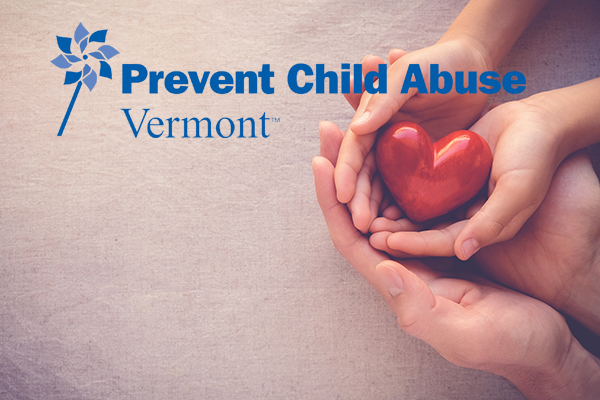
Featured Community Partner Prevent Child Abuse Vermont

Prevent
Child Abuse Vermont (PCAVT) has been doing vital work in our
communities for more than forty years, focusing on a variety of issues,
including child abuse prevention, shaken baby syndrome/abusive head
trauma prevention, and child sexual abuse prevention. One of the
organization’s priorities is taking on these issues in a comprehensive,
holistic way, incorporating everyone involved. Executive Director Linda
Johnson provides an example: “What’s comprehensive about all of the
programs for child sexual abuse is that we train the parents, the entire
school staff and faculty, and the school bus drivers get everybody on
the same page before we start with the children. This way everybody is
ready to understand and to help.”
One way PCAVT makes a difference in preventing child sexual abuse is by
bringing age-specific curriculum into schools, from third to eighth
grade, under the title of the Healthy Relationships Project. After
identifying the need to focus on middle-school ages, they developed the
SAFE-T program or Sexual Abuse Free Environment for Teens. Focusing on
7th and 8th grade, the program addresses the fact that a third of
childhood sexual abuse in Vermont is committed by youth with younger
children. PCAVT also offers the Care for Kids program, which had been
developed in Canada and is similar to SAFE-T but designed for kids aged
three through the 2nd grade. Finally, to bridge the gap, they developed
the We Care Elementary program, which covers 3rd through 6th grades.
Schools are just one of a range of places where PCAVT programs reach the
people who need them. For the past year, they’ve even offered a way to
help people via smartphones, through the Text4Baby program. Text4Baby
provides a smartphone app which provides parents with three pieces of
advice every week for the first year of life, including during
pregnancy. Less high-tech but just as important and useful is The
Vermont Parents’ Home Companion, which, Johnson says, “has information
from birth to 18 years of age. We update it every year, and we give it
out free, through the hospitals. We are making the 30th edition now,
each year we add another special piece, an article, something that’s
timely.”
Programs offered by PCAVT go from schools and hospitals to right into
the home with a number of resources for parents, from helplines to
support groups. Johnson notes there are many elements which contribute
to problems at home and assessing the best ways to deal with them. These
factors include poverty, unemployment, housing, domestic violence, the
generational cycle of abuse and addiction. “We, like many other states
across the country, are very much involved with helping people who are
addicted to recover from their addiction, and many of them are parents,”
she notes.
What Johnson refers to as “the hurried child” is another contributing
factor. As lives have gotten busier, it’s more and more challenging for
parents who have to juggle childcare, at home and outside the home, with
everything else going on in their lives. Johnson says, “There’s less
and less consistent nurturing family time. We think that’s a struggle.”
Exacerbating the situation is the lack of multi-generational homes or
homes with an extended family member, such as a grandparent, who is home
to watch the child all the time.
“If you really want to do a deep dive and you look for cultures where
there is no child abuse, you’re going to find how rare they were, but
you’re also going to find that there was a tremendous, deep respect for
life,” Johnson adds. “There’s no language for war or assault or
violence; it was just unimaginable. We want to make it unimaginable to
hurt a child, and we think, if it can be done, it can be done in
Vermont. We have a great responsibility, we feel, here in Vermont, to
push those numbers into oblivion. If we can do it here, there is hope.”
In the four decades, PCAVT has been working towards that goal; progress
has been made. “One of the most, if not the most, important thing that
has changed in these 40 years of our organization functioning, is that
the number of children who are found to be abused each year has dropped
dramatically, really dramatically,” Johnson says. “It’s overall a 74%
decline, and we could not be more proud of that.”
Another critical aspect of the organization’s success is getting
everyone, parents and children alike, the help they need, wherever that
help may be found. This often includes the Department for Children and
Families, as PCAVT is required to report if they suspect child abuse is
occurring. Johnson says they would rather the parent make that call
themselves, but they will do it for the parent if they’re too scared.
Other types of referrals also happen frequently, she says. “We always
refer. We refer to the food bank, we refer to everything because people
call with all kinds of different problems.”
Please visit Prevent Child Abuse Vermont
for more information about all of their efforts, how you can utilize
their free programs and resources, or how you can support the
organization’s work.
